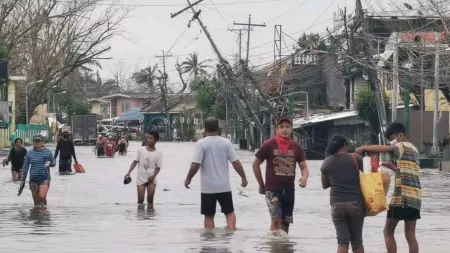Photo: @ACCORD_Inc /Bro. Ciriaco Santiago
Manila, Philippines - November 2, 2020 - As typhoon Goni weakens it has left a devastating wake - killing 16 people, affecting over 2 million people, destroying infrastructure and houses, and damaging crops across 12 regions.
Typhoon Goni has been 2020's strongest typhoon so far, with 215 kilometers per hour (133 miles per hour) sustained winds and gusts of up to 265 kph (164 mph). Goni made landfall four times in the provinces of Catanduanes and Albay in the Bicol Region, in San Narciso, Quezon, and Lobo, Batangas in the Southern Tagalog Region last November 1, 2020.
Volcanic mudflow has also ravaged municipalities around Mayon Volcano, leaving houses and crops completely covered.
“Apart from the current COVID-19 pandemic, the Philippines is also facing the start of the La Nina season. CARE is working with local government units in the Philippines to better prepare for upcoming typhoons under this pandemic. We need to ensure evacuation camps are safe spaces for women and girls, and that their specific needs are addressed,” said David Gazashvili, CARE Philippines Country Director.
More than 500,000 individuals are displaced and are currently in evacuation centers in the Bicol Region. As of November 2, there are also more than 300 confirmed cases of COVID-19 across Bicol. With limited spaces in evacuation centers, the risk of contracting the virus is very high.
Primary needs of the displaced population now are shelter kits, blankets, clothing, face masks, food, and water. CARE and partners are working closely with local government units to ensure support to vulnerable sectors, women, and girls affected by Typhoon Goni.
“Countries like the Philippines have suffered the brunt of the strongest typhoons ever recorded in this decade. Climate change is expected to worsen the intensity and frequency of extreme weather events such as typhoons. CARE is working with vulnerable communities in the Philippines who are the hardest hit of climate change,” shares MaryJoy Gonzales, CARE’s Partners for Resilience Project Manager.
CARE has been working in the Philippines since 1949, helping communities prepare for disasters, and providing emergency relief and recovery when disaster strikes. CARE has ongoing programs across the Philippines, including in the areas potentially affected by Typhoon Goni. CARE is sending a team to assess with partner organizations and local government units on the ground and provide response as needed.
For media inquiries, contact:
Rya Ducusin, Communications Specialist, CARE Philippines
[email protected] / [email protected]
